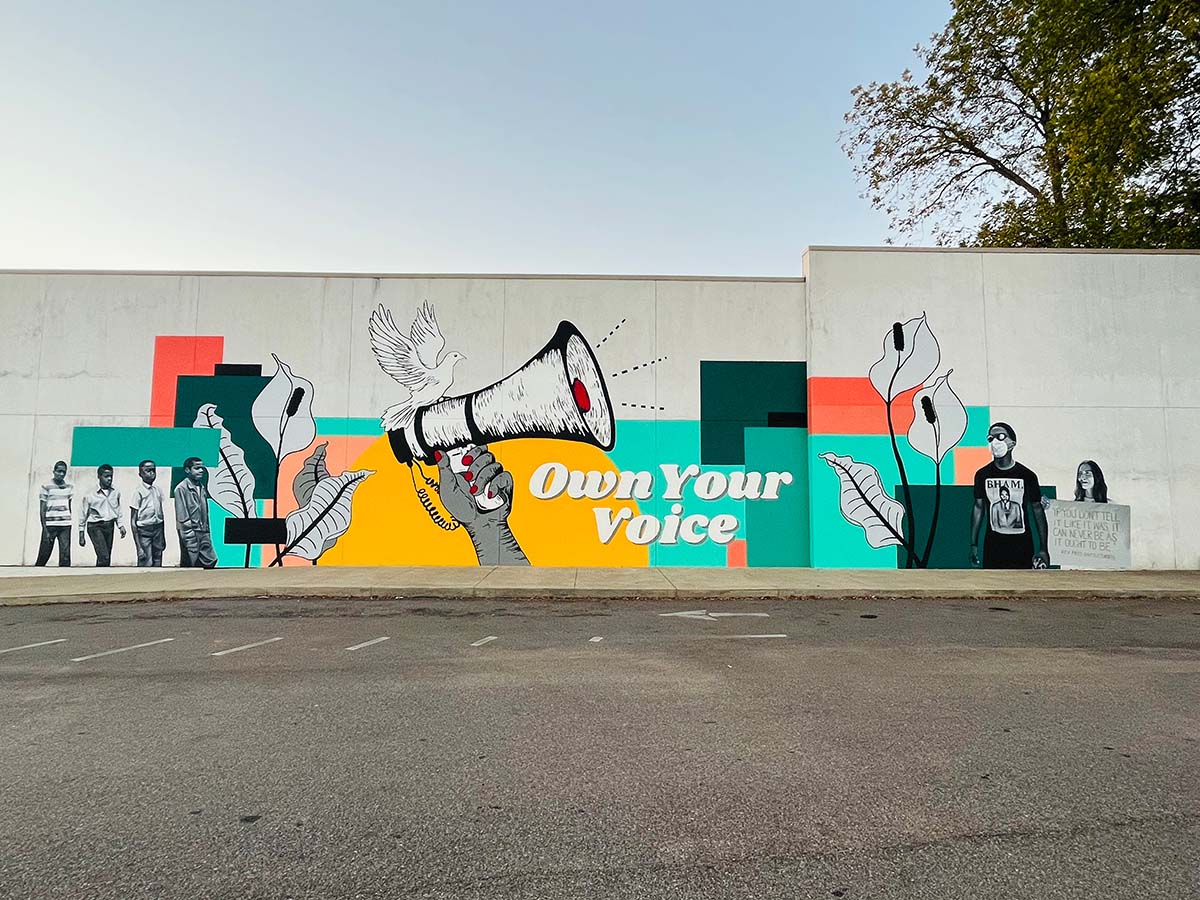
In Birmingham, FHI 360 and our partners worked with Blank Space Bham to install a mural that encourages community members to own their voice, start a conversation about the history of racial violence in Jefferson County and be part of social change. Photo: Ekta Saksena/FHI 360
For centuries, art has been used to spark conversations and social change. And murals painted on buildings are a powerful way to both turn art into activism and make art accessible to the community.
For the past two years, FHI 360’s social marketing and communication department has partnered with the Jefferson County Memorial Project (JCMP) and Kids in Birmingham 1963 on the Voices of Truth communication campaign, which is part of JCMP’s efforts to advance racial equity in Jefferson County, Alabama. The campaign engages county residents in cross-race dialogue as a pathway toward truth and reconciliation, digging deep into issues pertaining to equity, justice, community voices and more through methods such as billboards, conversation starter cards and social media posts.
Recently, our team traveled to Birmingham — the county seat of Jefferson County nicknamed “the Magic City” — to witness what was just a dream a couple of years ago: a mural that encourages community members to own their voice, start a conversation about the history of racial violence in Jefferson County and be part of social change.
Here are some of our takeaways from the campaign.
1. Context is key.
Before launching a campaign on a difficult topic like racial equity, understanding context is critical. So first, in addition to researching Birmingham’s history and its previous truth and reconciliation efforts, we — along with JCMP and Kids in Birmingham 1963 — met with community members and other community partners. This allowed us to better understand community members and experience the context our campaign would operate in. During our trip, we saw a city in the middle of a revitalization, drawing on its history to thrive again. We also saw a city facing social challenges and the remnants of the racial terror that earned the city a different nickname: “Bombingham.” After the trip, we were eager to use what we learned to contribute to the city’s evolution. Our mural was an opportunity to make a lasting impact.
2. Art has the power to inspire and transform.
The strategic use of imagery and messaging can challenge dominant narratives and inspire action. That’s why we worked with local artist and activist Meghan McCollum of Blank Space Bham and her team to install a mural in northeast Birmingham that encourages viewers to “Own Their Voice.” The mural takes us on a journey through time — from the boys marching in the 1963 Children’s Crusade in Birmingham, to the peace lilies memorializing victims of racial violence, to the protesters of today. The mural sparked conversations both as it was being painted and afterward. Curious passersby discussed racism with the mural’s creators, and parents walking by explained the images to their preschoolers.

On the left side of the mural, viewers can see boys marching in the 1963 Children’s Crusade in Birmingham and peace lilies memorializing victims of racial violence. Photo: Ekta Saksena/FHI 360

The right side of the mural depicts current-day protestors for racial equity. Photo: Ekta Saksena/FHI 360
3. Conversations are the catalyst to changing hearts and minds.
Central to our campaign was using cross-race dialogue about the region’s history of racial violence and current inequities to promote community change. We focused our messages on starting the conversation as a first step toward racial equity and developed conversation starter cards to guide difficult discussions about racism. At the mural’s unveiling, we talked with residents, shared our conversation starters and encouraged people to own their voice.
4. We cannot do racial equity work without fully engaging communities.
With the public and nonprofit sectors’ growing focus on racial equity, community engagement matters now more than ever. A traditional top-down approach won’t be as effective as one that meaningfully engages community members throughout the process. Solutions will be successful and sustainable only if they’re developed with the people in the communities where we work.
Effective community engagement gives us a better understanding of a community’s needs, strengths, hopes and fears. It increases transparency and builds trust between affected parties — values that are key to sustainable partnerships. In our campaign, the members of the community shaped our work at every step: understanding the history and context in Jefferson County; developing creative concepts and messaging; testing conversation starter cards; and determining the mural’s location, theme and design. While there’s always room for improvement, we understand we must first create space for the voices, experiences and perspectives of those directly affected.
As Birmingham prepares to commemorate 60 years since the 1963 civil rights campaign transformed the city, we’re exploring new ways to use these lessons to highlight the stories of Jefferson County residents and continue to support racial healing and reconciliation efforts.
